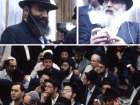Ki Sisa: Light Your Fire
Moshe asks Hashem to reveal Himself and is sent to the “Nikrat Hatzor” – a stone symbolizing repentance. There lies the root of mercy and atonement for the sin of the Golden Calf. But why there, of all places? • Full Article
BEGIN WITH A GRIN
An Arab went hunting in the forest with a rifle. He found a hole in the ground, bent down, and made a sound: “Woo…woo.” Suddenly, a sound was heard from the hole: “Woo…woo.”
Then a small rabbit came out of the hole, and the Arab hunted it without any problem. This continued several times, with the hole growing larger each time, and with it, the animal that came out of the hole was that much bigger. At first it was a rabbit, then a fox, then a bear, and more.
Proud of his success, the hunter continued his journey and reached a h-u-g-e cave. He stood at the entrance and called: “Woo…woo.” Something inside answered him: “Shick…shick.” The hunter continued and made the sound again: “Woo…woo,” and something inside answered him: “Too…too.” The hunter got excited, cocked his weapon, and intended to hunt the giant animal until… The train came out of the cave and ran him over!
FIRE IN THE HOLE
The central story in parshas Ki Tisa is the Cheit HaEgel (sin of the Golden Calf), with an important part of this story dealing with the tikun of the sin. Without going into all the lengthy details described in the Torah, we will focus this week on a short section of the parsha dealing with the Thirteen Attributes of Mercy.
Moshe asks G-d to see His face, and G-d promises Moshe that He will teach him how to request and arouse mercy when needed, through reciting the Thirteen Attributes of Mercy, as we do in prayer every day, and especially on fast days or days of Selichos, when we need a special awakening of mercy.
In the introduction to this divine revelation, G-d tells Moshe something interesting: “And it shall be, while my glory passes by, that I will put you in a cleft of the rock, and will cover you with My hand until I have passed by” (Ki Sisa 33:22). Why does Hashem put Moshe in a “cleft of the rock?” And what exactly is this cleft of the rock – some hole in a desert mountain? An ancient hollow stalactite cave?! Sounds strange, doesn’t it?!
The simple explanation, known to everyone, appears in Pesikta Rabbasi, which states that Moshe hid in the cleft of the rock from the wrath of the angels. “What did Moshe do? He sat in the cleft of the rock until G-d passed by. Angels came to harm Moshe. What did G-d do? He protected him with His hands. And from there Moshe received the rays of glory.” According to this, the cleft of the rock was like an underground bunker, a kind of tunnel where one hides in order not to be harmed by “enemy fire.” Sounds familiar?!
But when examining the language of the Medrash (quoted above), a simple yet powerful question arises about this whole need for the “cleft of the rock.” If, after all, Hashem protected Moshe anyway by placing His “palm” over him, then what need was there to hide in the cleft of the rock? Moshe did not need to sit in some underground tunnel for his personal safety; he had a ‘divine armor’ that covered him from head to toe. G-d’s own hand protected him! So why the rock? Why the cleft? Why the ‘bunker’?
In Chassidic teachings, we find a wonderful explanation that explains the crux of the matter, while teaching us an important moral lesson in our divine service – how we should bring about our personal Geula and through it, the general Geula for all of Am Yisrael.
The Thirteen Attributes of Mercy that G-d revealed to Moshe at that event are the root of teshuva. Through drawing down these Thirteen Attributes, we can rectify all flaws and atone for all our sins. But in order to draw down these Thirteen Attributes of Mercy, to reach them and arouse them to be revealed to us here in this world, we need to reach their source, their spiritual ‘root.’ The Jew who desires to rectify his soul needs to reach the ‘root’ of the Thirteen Attributes, to the supreme source from which they are drawn, and from there – from the source – to draw them down into the world. What is the source? Where is this coveted ‘root’ found?
The ‘root’ of the Thirteen Attributes of Mercy is in… the cleft of the rock! Therefore, Moshe needed to stand in the “cleft of the rock” in order to reach the source, and from there bring atonement and rectification for the sin of the Golden Calf.
What is the inner meaning of the “nikras ha’tzur” (cleft of the rock)? Why does a hole carved in rock symbolize the root of atonement?
“Tzur” is not an ordinary stone; it’s a special type of stone that has the power to ignite fire. The flint stone symbolizes the source of fire, the spark that comes out of the rock through strong striking, and from that spark, one can light a large fire. But to get a spark from the rock requires strength; one needs to strike hard! One cannot be satisfied with a light breath (as one would to bring out fire from a burning coal); one needs to strike with great force. This is a physical symbol for how the avoda of teshuva should be done. The avoda of teshuva must be done with “cheila yatir” – with great strength. One cannot be satisfied with a “teshuva compromise,” a “light and easy teshuva,” because with light teshuva, one doesn’t get any “fire” and doesn’t reach the root of atonement and forgiveness!
READY, AIM, FIRE
In light of the above, the Rebbe explains the verse quoted above in an innovative and inspiring way. “And it shall be, while my glory [kavod] passes by” – there is no “kavod” except Torah, and when a Jew “passes over” the Torah and sins, “I will put you in the cleft of the rock” – he needs to reach up to and stand within the source of fire, within the source of the divine spark, meaning he needs his teshuva to be done with “cheila yatir,” great strength and force of striking against the animal soul and the evil inclination.
Sounds very aggressive… quite forceful… the Torah demands “fire” and “striking”… What about some chesed? What about some mercy?
The Rebbe explains that although “fire” originates from the divine attribute of Gevura (strength/severity), and we usually prefer to hear more about the divine attribute of Chesed and mercy, and not so much about the attribute of Gevura, there are things that only “Gevura” can accomplish. The Rebbe explains three wonderful virtues that, in order to receive them, we need to awaken the attribute of Gevura within ourselves to reach the divine Gevura.
- In Gevura, there is more chayus (vitality) than in Chesed. Indeed, Chesed gives to everyone, but it does so languidly, out of its inherent nature, and without any special feeling. In contrast, Gevura does not give to everyone, but whoever is privileged to receive from it gets infinitely and without any restraints. The Rebbe illustrates this difference with a physical example: the difference between domestic animals and wild animals. The root of domestic animals is in Chesed, while the root of wild animals is in Gevura. Indeed, domestic animals have a lot of strength – “an ox for the yoke and a donkey for burden” – but they move sluggishly and lack the agility that comes from excess energy. In contrast, wild animals move quickly and swiftly, which comes from their vitality, rooted in the attribute of Gevura.
- Divine abundance reaches farther when using the attribute of Gevura. A physical example of this is: “Words that come from the heart enter the heart.” Even if the listener is “very far” from the speaker’s spiritual world – they’re not on the same wavelength at all – nevertheless, since the speaker speaks with excess inner vitality, speaking from the heart, from their inner fire, from their inner Gevura, the words also enter the heart of a person who is very distant.
- Through Gevura, divine abundance is divided into small parts, which we can internalize and receive. A physical example of this is rainfall, which is called in the Torah “Gevuros Geshamim” (the might of rain) because Gevura causes the rain to be divided into droplets. If the rain were not divided into drops and just fell like an infinite stretch of water, we would have a flood!
So after all, there are many good and necessary things in a bit of inner Gevura and a bit of divine Gevura.
But here the question arises: what about someone who has not sinned? How will he reach the “cleft of the rock,” all those wonderful virtues that exist only among baalei teshuva, who serve G-d with a little (or a lot of) Gevura?!
That’s why G-d specifically placed Moshe in the cleft of the rock, because he too, did not sin! He wasn’t even in the vicinity of the sin; he was up in heaven. Nevertheless, G-d placed Moshe in the cleft of the rock, because Moshe symbolizes the tzaddik who did not sin, and teaches us that even “completely righteous people” need to become “baalei teshuva” and serve G-d with their inner fire, with their inner spark, with the “rock” of their soul.
This is also the work of Moshiach Tzidkeinu, as is known from the words of the Zohar that “Moshiach comes to bring the righteous to teshuva,” Melech HaMoshiach is (also) going to bring the completely righteous to teshuva. And this is the way to reach the personal Geula of each and every one of us, and through this personal Geula, we reach the general Geula of the entire Jewish people.
When each of us stands in the “cleft of the rock,” like Moshe, and uses our inner fire for the purpose of avodas Hashem, we will redeem ourselves. And our strength to stand “in the cleft of the rock” comes from Moshe, the Moshe of each generation, the tzaddik who did not sin who teaches us how to bring our inner fire into action, right now!
TO CONCLUDE WITH A STORY
Let’s end with a short Chassidic story about the power of Chassidic Gevura expressed in “words that come from the heart and enter the heart.” I heard the following story from Rabbi Tuvia Bolton of Kfar Chabad:
Once he was traveling on a train with the well-known mashpia, Rabbi Mendel Futerfas. He went around the carriages offering passengers to put on tefillin. It was hard to refuse a Jew like him. Jews rolled up their sleeves and put on tefillin one after another.
And here, R’ Mendel approached one Jew and asked him to put on tefillin. The Jew refused and even raised his voice and shouted at Rabbi Mendel, pouring out all his bitterness about “the religious” and “the parasites,” etc.
R’ Mendel remained calm, and with a big smile and in old Ashkenazi pronunciation said to the man, “But I love you!” (It sounded like: “Avoyl ani oyheiv oysoch”). The Jew continued to fume and grumble, and Rabbi Mendel repeated the line “But I love you,” again and again.
The end is already clear. They didn’t move from there until that Jew rolled up his arm, put on tefillin, and even hugged and kissed R’ Mendel.
Good Shabbos!
15
Join ChabadInfo's News Roundup and alerts for the HOTTEST Chabad news and updates!









































